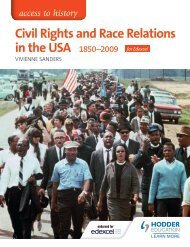SAMPLE
Sample-chapter-for%20Early-Elizabethan-England,-1558-1588,-Student-Book
Sample-chapter-for%20Early-Elizabethan-England,-1558-1588,-Student-Book
You also want an ePaper? Increase the reach of your titles
YUMPU automatically turns print PDFs into web optimized ePapers that Google loves.
1.4 The problem of Mary, Queen of Scots<br />
1.4 The problem of Mary, Queen of Scots<br />
Learning outcomes<br />
••<br />
Understand why Mary, Queen of Scots, had a claim<br />
to the English throne.<br />
••<br />
Understand the relationship between Mary, Queen<br />
of Scots, and Elizabeth I between 1568–69.<br />
••<br />
Examine the evidence for and against Mary, Queen<br />
of Scots’ accusation of murder.<br />
Timeline<br />
Mary, Queen of Scots<br />
1559 The Scottish<br />
Protestant lords’<br />
rebellion begins in<br />
Scotland<br />
1561 Mary returns<br />
to Scotland after the<br />
death of her husband,<br />
King Francis II of France<br />
1566 Mary gives birth<br />
to a son, James<br />
1568 Mary escapes and<br />
raises an army against<br />
the Scottish Protestant<br />
lords but is defeated.<br />
She flees to England<br />
1569 Mary is implicated<br />
in a plot against<br />
Elizabeth I, and is<br />
placed under house<br />
arrest in England<br />
1560 The Scottish<br />
Protestant lords’<br />
rebellion ends<br />
King Francis II of France<br />
dies<br />
1565 Mary marries<br />
Henry Stuart, Lord<br />
Darnley<br />
1567 Lord Darnley is<br />
murdered and Mary<br />
marries the Earl of<br />
Bothwell.<br />
The Scottish Protestant<br />
lords rebel against<br />
Mary. She is forced<br />
to abdicate and is<br />
imprisoned<br />
Mary, Queen of Scots’ claim to the English<br />
throne<br />
As noted earlier, Mary, Queen of Scots, was a Catholic<br />
with a strong claim to the English throne. She was Henry<br />
VII’s great granddaughter, Elizabeth I’s second cousin,<br />
and there were no issues about her legitimacy. Born on<br />
8 December 1542, she became queen of Scotland at six<br />
days old after her father, King James V, died. Her mother,<br />
Mary of Guise, was from a very powerful Catholic, and<br />
French, noble family.<br />
The Treaty of Edinburgh, 1560<br />
In 1560, Elizabeth helped Scotland’s Protestant lords<br />
defeat Mary of Guise, who had been ruling Scotland for<br />
her daughter, Mary, Queen of Scots, whilst she was in<br />
France with her husband, King Francis II.<br />
The Scottish Protestant lords rebelled because they<br />
did not like the French, Catholic influence brought to<br />
Scotland by Mary of Guise. Although Elizabeth was<br />
cautious to send help to a rebellion which could see the<br />
deposing of an anointed* monarch, she was also under<br />
constant threat: with French help, Mary, Queen of Scots,<br />
could take her throne. With the encouragement of her<br />
advisers, Elizabeth secretly sent money to help the<br />
rebels, and eventually sent troops, too.<br />
Key term<br />
Anointed*<br />
During a coronation, holy oil is applied to the<br />
monarch. This is known as ‘anointing’ and is the most<br />
important part of the coronation as it is when the<br />
person becomes the monarch.<br />
Draft material<br />
The rebellion ended with the Treaty of Edinburgh in<br />
1560. The treaty said that Mary, Queen of Scots, would<br />
give up her claim to the English throne. After the<br />
unexpected death of her husband, King Francis II of<br />
France, in December 1560, Mary returned to Scotland<br />
from France. Although she was queen, the Protestant<br />
lords controlled the Scottish government.<br />
Mary herself never approved the treaty, and maintained<br />
that she had a claim to the English throne. She wanted<br />
to be named as Elizabeth’s heir.<br />
Elizabeth had no intention of naming any heir, however,<br />
and choosing Mary would divide England: she would be<br />
popular with Catholics, but not Protestants. Divisions<br />
would damage the kingdom and weaken Elizabeth’s<br />
position.<br />
Extend your knowledge<br />
Decision to help the rebels<br />
Elizabeth was only persuaded to help the Scottish<br />
Protestant lords’ rebellion in 1560 because Sir William<br />
Cecil persuaded her. In fact, he threatened to resign<br />
if she didn’t. It was important for England to have<br />
a friendly, Protestant, anti-French government in<br />
Scotland.<br />
Key term<br />
Abdicate*<br />
A king or queen giving up their throne.<br />
Source A<br />
Mary, Queen of Scots’ arrival in England,<br />
1568<br />
Mary married her second husband, Henry Stuart, Lord<br />
Darnley, in 1565. She gave birth to their son, James,<br />
in 1566. In 1567, Darnley was murdered, probably by<br />
the Earl of Bothwell and Mary was suspected of being<br />
involved. In fact, she married Bothwell soon after<br />
Darnley’s death, which for many was admission of her<br />
guilt.<br />
The scandal led to the Protestant Scottish lords<br />
rebelling again. They forced Mary to abdicate* in favour<br />
of her baby son, James. She was imprisoned in a castle<br />
on an island in the middle of a loch (lake), but escaped<br />
in 1568 and raised an army in an attempt to win back<br />
her throne. Mary’s forces were defeated at Langside,<br />
near Glasgow, and she fled to England, seeking<br />
Elizabeth I’s help against the rebels.<br />
A 16th century Scottish painting of Mary, Queen of Scots (right), and her husband, Henry Stuart, Lord Darnley. Lord Darnley<br />
was Mary’s distant cousin and also descended from King Henry VII, so he too had a claim to the English throne.<br />
Draft material<br />
32<br />
33




